Labra recipe aka bengali labra is an exemplary and inimitable Bengali mixed vegetable curry which is prepared in puja festivals like Durga Puja, Laxmi Puja, Saraswati puja etc. and offered to the Goddesses as Prasad. It is a slobbering and comforting vegetable mishmash which is loved by the people of all age groups. Bengalis have an eternal love with the bhoger labra recipe and have retained the recipe with exceptional popularity from ages. In this preparation, array of vegetables are cooked with panch phoran and Bengali bhaja masala in mustard oil. It is mostly accompanied with bhoger khichuri but can also be paired up with steamed rice or flat bread like Roti, luchi etc.
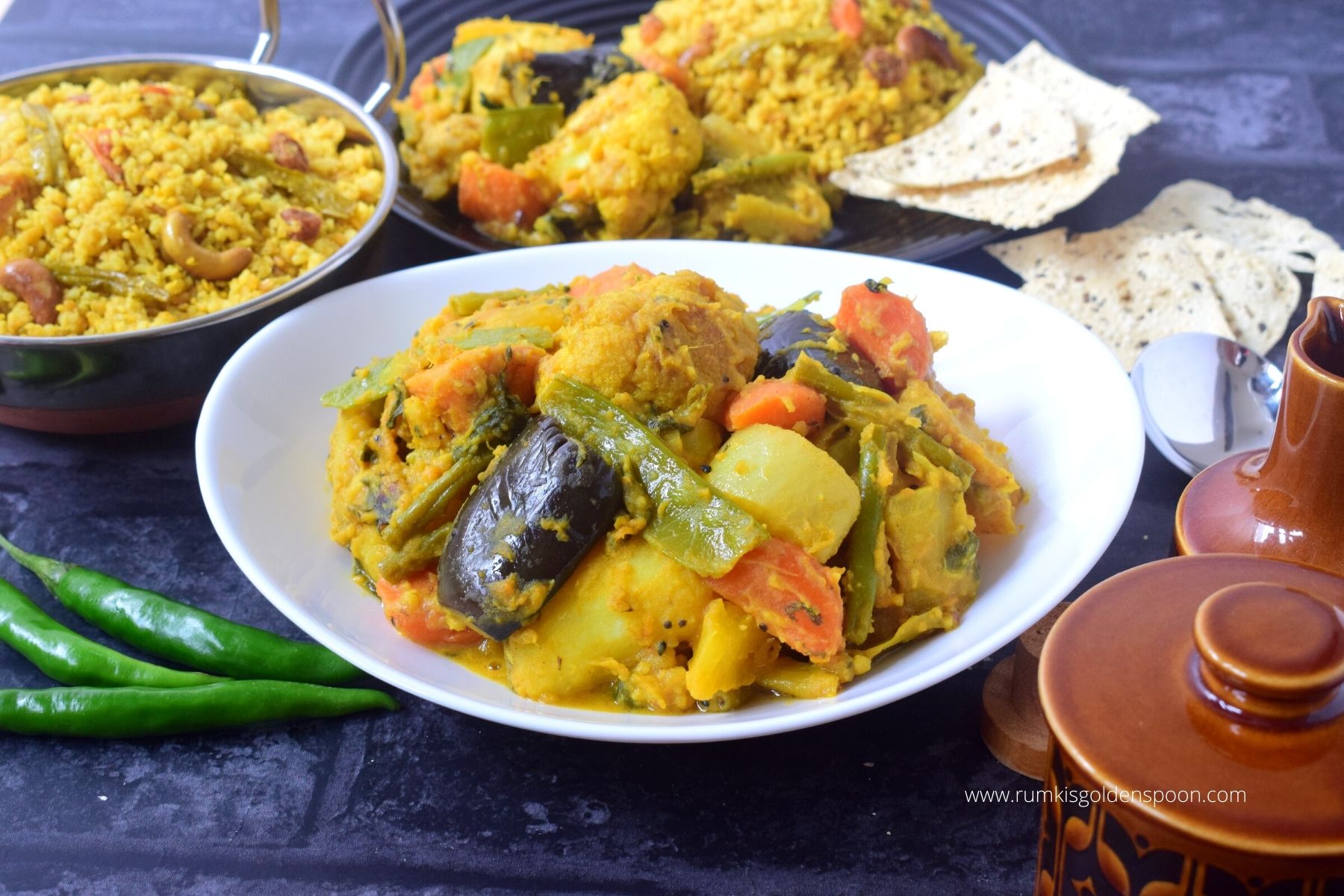
Table of Contents
About the recipe
Tips and Suggestions
How to make Labra (step wise photos)
Recipe Card
What is labra?
Labra recipe is a specific bengali mixed vegetable curry prepared with different ranges of vegetables like pumpkin, brinjal, ridge gourd, radish, carrot, raw banana, sweet potato, potato, cabbage, cauliflower, broad beans etc. It is a niramish recipe aka no onion no garlic recipe which is frequently prepared in Bengali houses in vegetarian days aka meatless days. Bengali labra is basically a vegetable mishmash prepared in Bengali spices which does not contain any gravy and at the same time not as dry as bhaji. It is mostly accompanied with khichuri, steamed rice and even with flat breads like roti, paratha, luchi etc.
Other than this, bhoger labra recipe has a tremendous contribution in Bengali culture and Bengali culinary. Any puja festival’s bhoger prasad is incomplete without khichuri-labra.
According to me, there is no Bengali who has never tasted bhoger labra at least once in their lifetime. Everyone, from kids to grown-ups, just love labra recipe and devour it with utter satisfaction. For any puja, whenever prasad is distributed, bhoger khichuri & labra always drags everyone’s special attention.
As a bong, I have grown up eating this divine and it totally engages me every time with its irresistible taste, unbeatable flavour and amazing texture. I have thousands of good memories with the traditional Bengali food and whenever I talk about it, I feel nostalgic. My mom used to prepare Bengali labra frequently on meatless days (Saturdays for our family) and puja festivals.
Since my childhood, I have seen my mom and dad celebrating Lokkhi puja and Saraswati puja at home every year. Dad used to buy myriad vegetables the day before puja and mom used to cut and clean it early morning of the puja day. She used to cook bhoger labra in separate kitchen using separate utensils for the people who used to come to have prasad.
I still remember how my mom used to prepare huge amount of bhoger khichuri, bhoger labra recipe, payesh and chatni for friends, relatives and family on Lokkhi puja. We used to fast on the puja days and always used to get tempted by the smell of Bhoger prasad while it was being cooked. We would be waiting from morning to have Bengali khichuri and Bengali labra recipe with other prasad. Anyone who came to our house at the evening to have prasad used to devour the khichuri-labra with ultimate satisfaction.
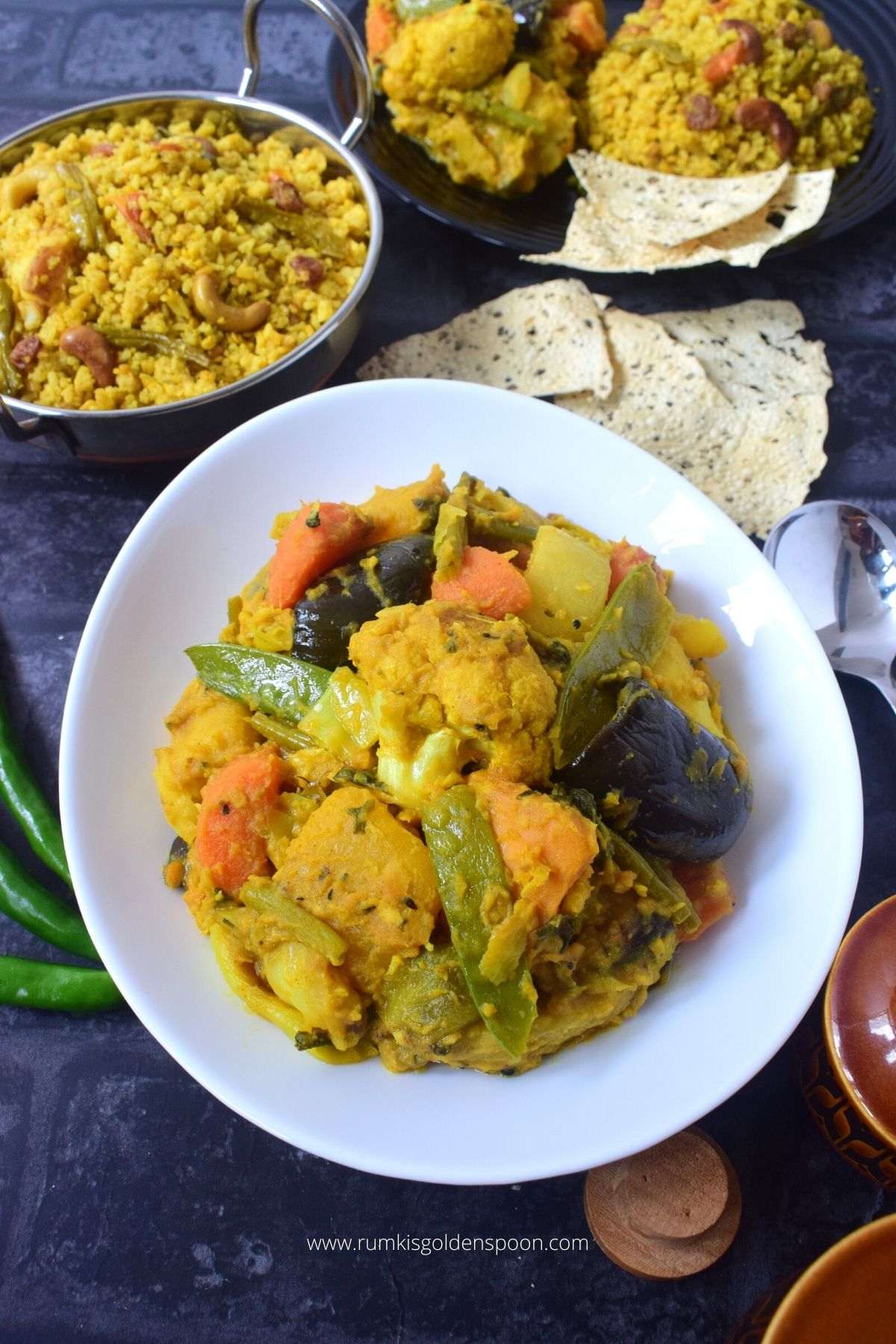
I have learnt the bhoger labra recipe from my mom and she learnt it from her mom. So, you can consider it more than a hundred years old recipe. Even our brahmin thakur prepares the labra recipe in the same way. Preparing perfect bhoger khichuri is little bit tricky because every individual vegetable has different cooking time so must be cooked in a particular sequence.
All thanks to my mom. It is both because of her and grandma that I know all the techniques to prepare perfect bhoger labra. So, whenever anyone asks me about the recipe, I always give them a lot of Gyan. Sometimes doing decent show off is fun 😊.
First, bhoger labra recipe aka Bengali labra is a pure niramish recipe which is prepared in vegetarian way. Though this dish is prepared with veggies but still Bengalis are scrupulous about vegetarian food and they split it into two different parts. One division is called satvik food where onion, garlic and even masoor dal are prohibited along with non-vegetarian items. In another division, normal vegetarian dishes are prepared using onion and garlic. Onion and garlic are considered as rajasik food which produces heat in our body and inflame our passion and incomprehension. This labra recipe belongs to satvik food family which is prepared without using onion and garlic.
To prepare bhoger labra recipe, you would need a little bit of arrangement and ample amount of time for preparation and to cook the recipe. It is a pure Bengali delicacy, and it requires core Bengali ingredients, including the specific whole spice and spice blend to get prepared. Labra recipe always taste better when it is prepared in larger quantity. The more varieties of vegetables you add, it will taste better.
Labra recipe with step by step photos and instructions have been provided in the ‘Instructions’ section of the recipe. I have included all the tips and tricks to prepare perfect Bengali labra where all the veggies get cooked perfectly but does not get mashed. If you follow the steps precisely then this recipe will remind you of the Durgashtamir bhog. But before directly jumping into the recipe, let me share few interesting facts about the Bengali veg recipe.
Tips to prepare perfect Bhoger Khichuri
- Always cut the vegetables in big sizes or they will get mashed at the end of cooking.
- Please follow the sequence of adding vegetables to get the perfect chunky texture of the labra recipe. Every vegetable has different cooking time. So, don’t add all of them together or else the labra will become completely mushy.
- Always use mustard oil to cook Bengali labra. It gives better flavour and taste to the dish.
- Fry the brinjals, cauliflower, broad beans separately and add them later or else it will either get mashed or would not taste good.
- Grated coconut is an important ingredient to enhance the taste and flavour of the dish. On regular day’s labra recipe, you can skip it but for bhoger labra recipe, it’s a must.
- Make a separate masala paste of ginger, turmeric powder, red chilli powder and cumin powder to make the recipe handy or else it is difficult to mix each ingredient separately. You can also add chilli paste into the masala paste if you like to add some heaty taste into the labra.
- Panch phoron plays an important role to flavour up the dish. So, don’t skip the whole spices from the recipe.
- Don’t add any extra water during the time of preparing labra. All the veggies will get cooked in their own juice.
- Always try to prepare a fresh batch of bhaja masala for labra recipe. It’s a must, don’t skip it or replace it with other spices.
- Add little bit of sugar into the curry. Bengali labra is slightly sweet in taste. Addition of sugar enhances the taste of the dish.
- Don’t skip ghee at the end. It gives incredible flavour and taste to the bhoger labra.
- In few places due to weather condition vegetables contain more moisture. Hence, the cooking time may vary.
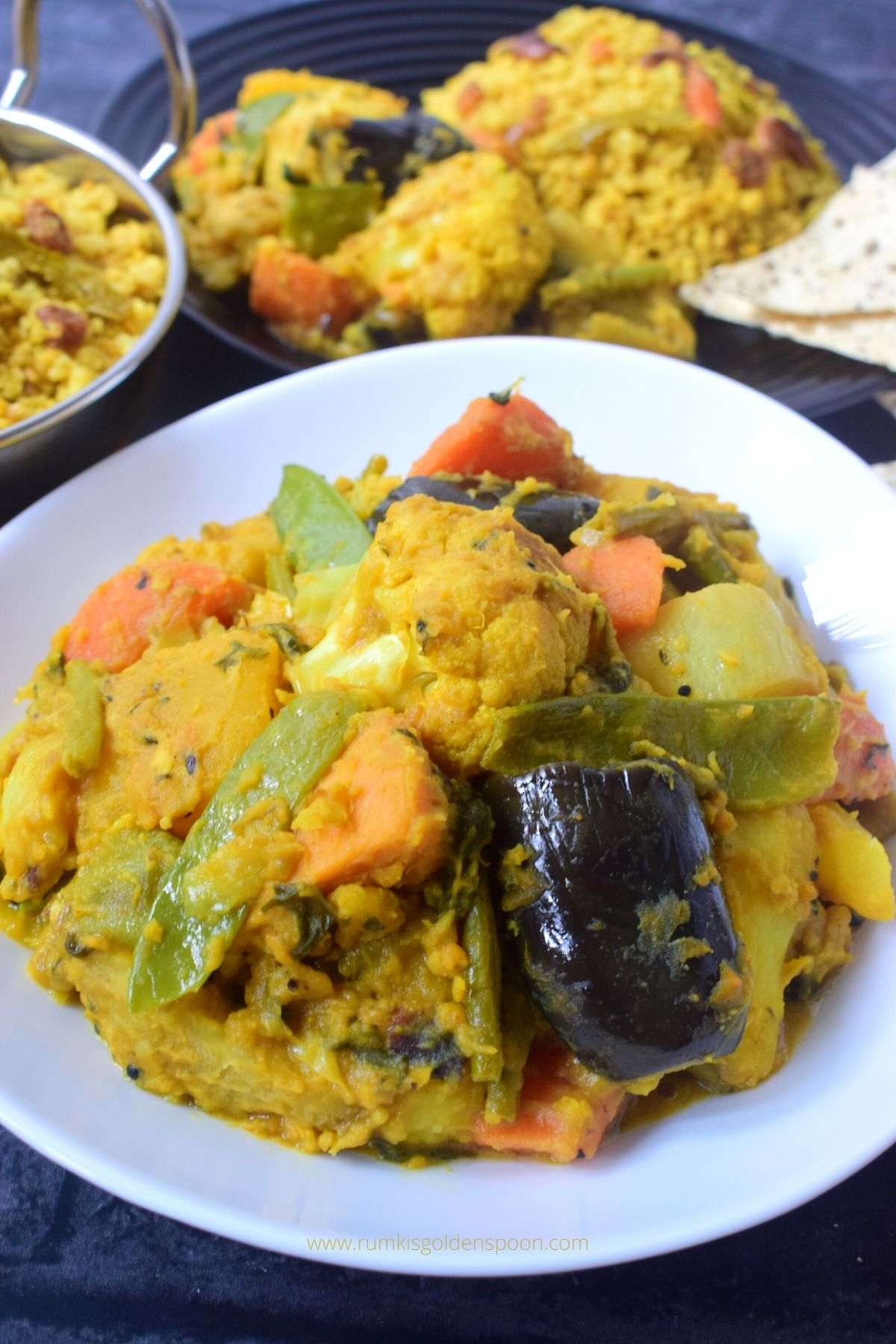
How to serve labra?
According to me, Bengali labra is one of the most versatile curries which can be accompanied with khichuri, bhuni khichuri, plain rice and even with flat bread like luchi, paratha aka porota, ruti etc.
How to make labra?
To prepare the labra recipe, first peel the vegetables and wash them. Then cut the potatoes, sweet potatoes, taro, carrots, radish, brinjal, pumpkin and ridge gourd into large pieces. Cut the cauliflower into large florets and chop the cabbage roughly into medium pieces. Peel the raw banana carefully and cut them into large pieces. Trim the edges of the broad beans and borboti and cut them into 3 inches pieces. Wash the spinach thoroughly and chop them. Keep all the vegetables aside.
Now take a small bowl and add ginger paste, turmeric powder, red chilli powder, cumin powder and some water into it. Make a paste of the spices and keep it aside. You can also add green chilli paste into the mixture if you prefer heaty taste.
Now put a large pan on flame and allow it to become completely dry. Then add mustard oil into the pan and wait until the oil is hot. Generally, most of the traditional Bengali food is cooked in mustard oil. It gives an outstanding flavour to the dish.
Add the cauliflower florets into the pan and fry them on high flame for couple of minutes until brown spots occur on the body of the florets. Strain the excess oil and transfer the florets on a separate plate. Then add the brinjal pieces into the pan and fry them over medium high flame for 2-3 minutes. Most probably the brinjal will soak most of the oil of the pan. Keep it aside. Add the broad beans into the pan and fry them over high flame for a minute and transfer them to a plate.
Add some mustard oil into the same pan and allow the oil to become hot. Add panch phoran, bay leaves, dry red chillies into the pan and let them crackle.
Add the potatoes and taro pieces into the pan and fry them over high flame for 2-3 minutes. Stir frequently.
Then add the carrots, sweet potatoes into the pan and fry them evenly for another 2-3 minutes over high flame.
Now, add the pumpkin, radish, cabbage pieces into the pan and give a nice mix. Cook it over high flame and stir nicely for 2 minutes. Then put the flame in medium and cover the pan for 5-6 minutes.
Then add fried cauliflower florets, raw banana, borboti (Yard long beans) and ridge gourd into the pan and give a nice mix. Cover the pan and cook it in medium flame for another 10 minutes. Stir twice in between. Take off the lid and give a nice mix.
Add the chopped spinach, salt, one by one into the pan and give a nice mix. Cover the pan and cook it over medium flame for another 5 minutes.
Add grated coconut into the pan and give a nice mix. Cover the pan and cook it over medium flame for another couple of minutes. Then add the masala paste into the pan and mix it well. Add the fried broad beans and mix it well. Again, cover the pan and cook it over low flame for 10-15 minutes until the all the vegetables get cooked. Stir in between.
Add the fried brinjal pieces, green chillies, sugar into the pan and mix it well. Cover the pan and cook it in low flame for another 5-6 minutes. Check all the vegetables whether they are cooked or not. If not, then cover the pan and cook it in low flame for another 2-3 minutes.
Add the bhaja masala, ghee into the pan and give a nice mix. Put the flame in high and cook it for a minute. Stir in between. Then switch off the flame and cover the pan. Don’t disturb the pan for another 10-15 minutes.
Many Bengali veg recipes for puja festival have already shared in my previous posts. You can check few of them like
Chanar dalna
Aloo posto
Bandhakopir Ghonto
Potoler dalna
..And Many more…
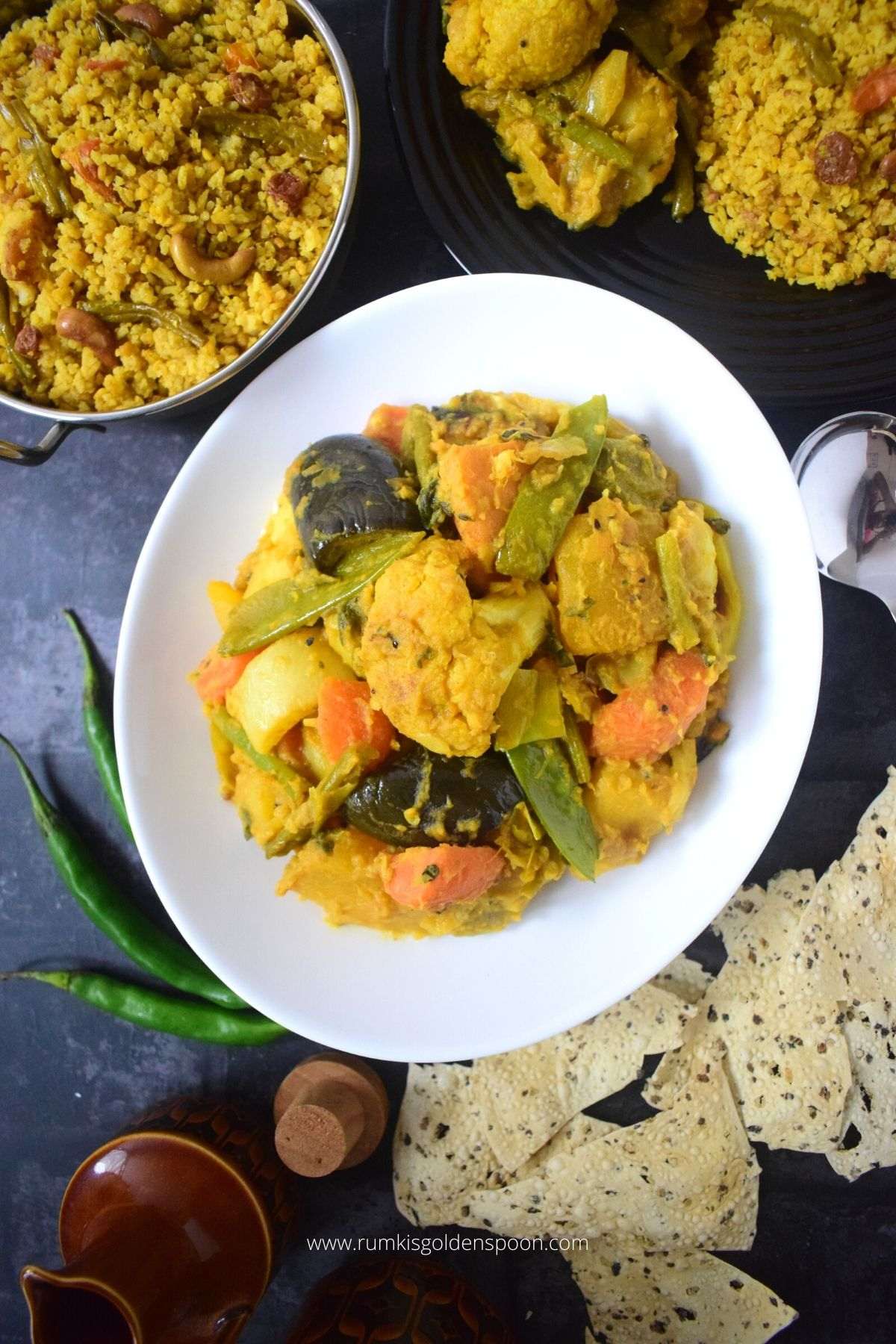
Ingredients:
1 cup = 250 ml
- 2 medium Potatoes
- 1 large sweet Potato (Mishti aloo)
- 3 Taro roots (Gathi kochu)
- 300 grams Pumpkin (Kumro)
- 1 large Radish (Mulo)
- 2 Medium Carrots
- 1 unripe Banana (Kachakola)
- 1 large Ridge Gourd (Jhinge)
- 10 large florets of Cauliflower
- 1 small Cabbage
- 1½ cup Spinach, chopped
- 100 grams broad Beans (Sheem)
- 100 grams Yard long Beans (Borboti)
- 3-4 green Chillies
- ¾ cup Coconut, grated or paste
For tempering
- ½ tablespoon Panch Phoran
- 2-3 Bay leaves (Tejpatta)
- 3 dry red Chillies (Shukno lonka)
For masala paste
- 1½ tablespoons Ginger paste
- 3 teaspoons Turmeric powder
- 2-3 teaspoons red Chilli powder (Adjust accordingly)
- 1½ teaspoons Cumin powder
- 3 tablespoons Water
Other ingredients
- 1 tablespoon Bengali bhaja masala
- 2 teaspoons Sugar
- Salt to taste
- 1 tablespoon clarified Butter (Ghee)
- 155ml Mustard Oil for cooking (App. ½ cup +1 tablespoon)
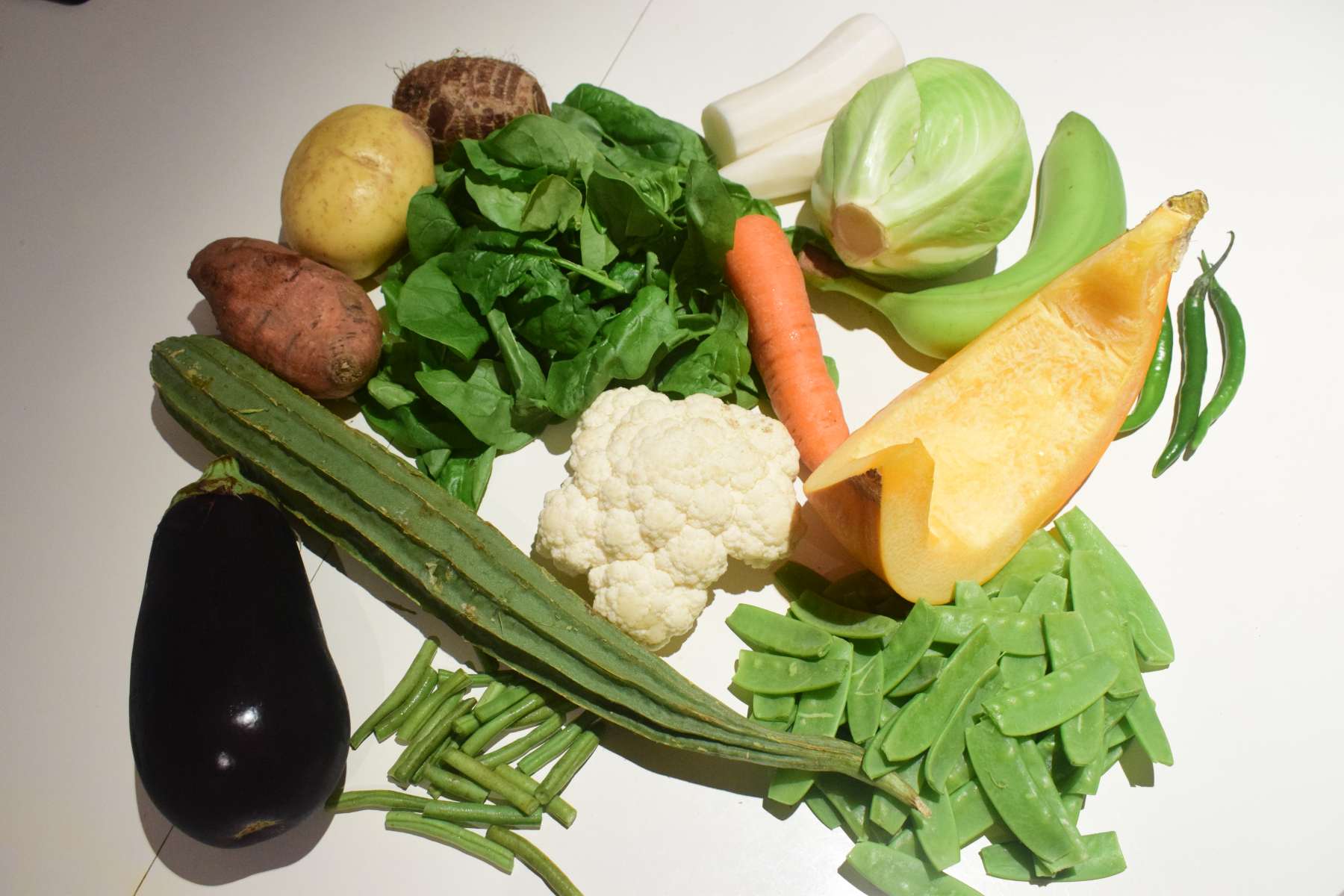
Instructions:
- Peel the vegetables and wash them. Then cut the potatoes, sweet potatoes, taro, carrots, radish, brinjal, pumpkin, ridge gourd into large pieces. Cut the cauliflower into large florets and chop the cabbage roughly into medium pieces. Peel the raw banana carefully and cut them into large pieces. Trim the edges of the broad beans and borboti and cut them into 3 inches pieces. Wash the spinach thoroughly and chop them. Keep all the vegetables aside.
- Now take a small bowl and add 1½ tablespoons ginger paste, 3 teaspoons turmeric powder, 2-3 teaspoons red chilli powder, 1½ teaspoons cumin powder and 3 tablespoons water into it. Make a paste of the spices and keep it aside.
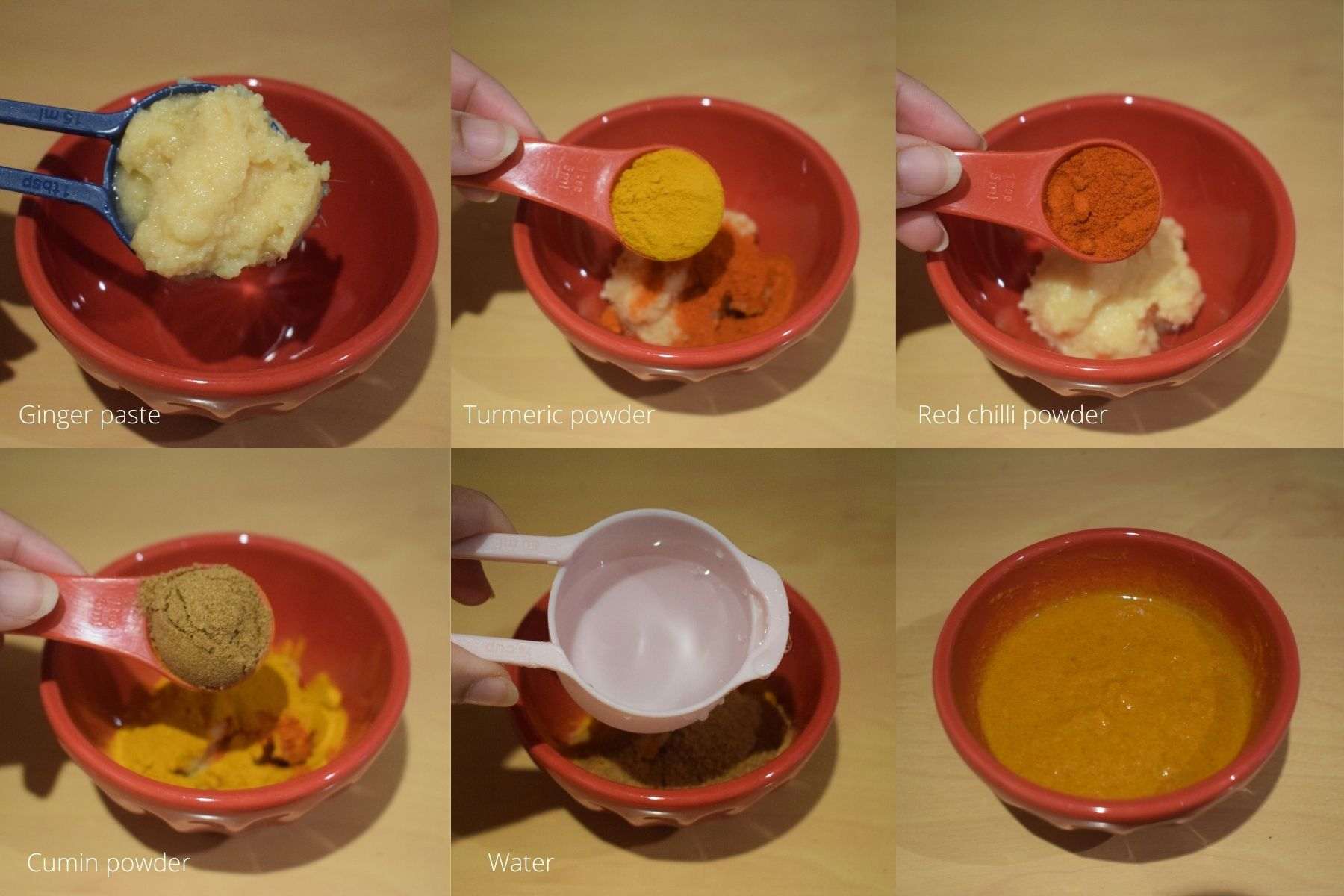
Note: You can also add green chilli paste into the mixture if you prefer heaty taste. - Now put a large pan on flame and allow it to become completely dry. Then add ¼ cup mustard oil into the pan and wait until the oil is hot.
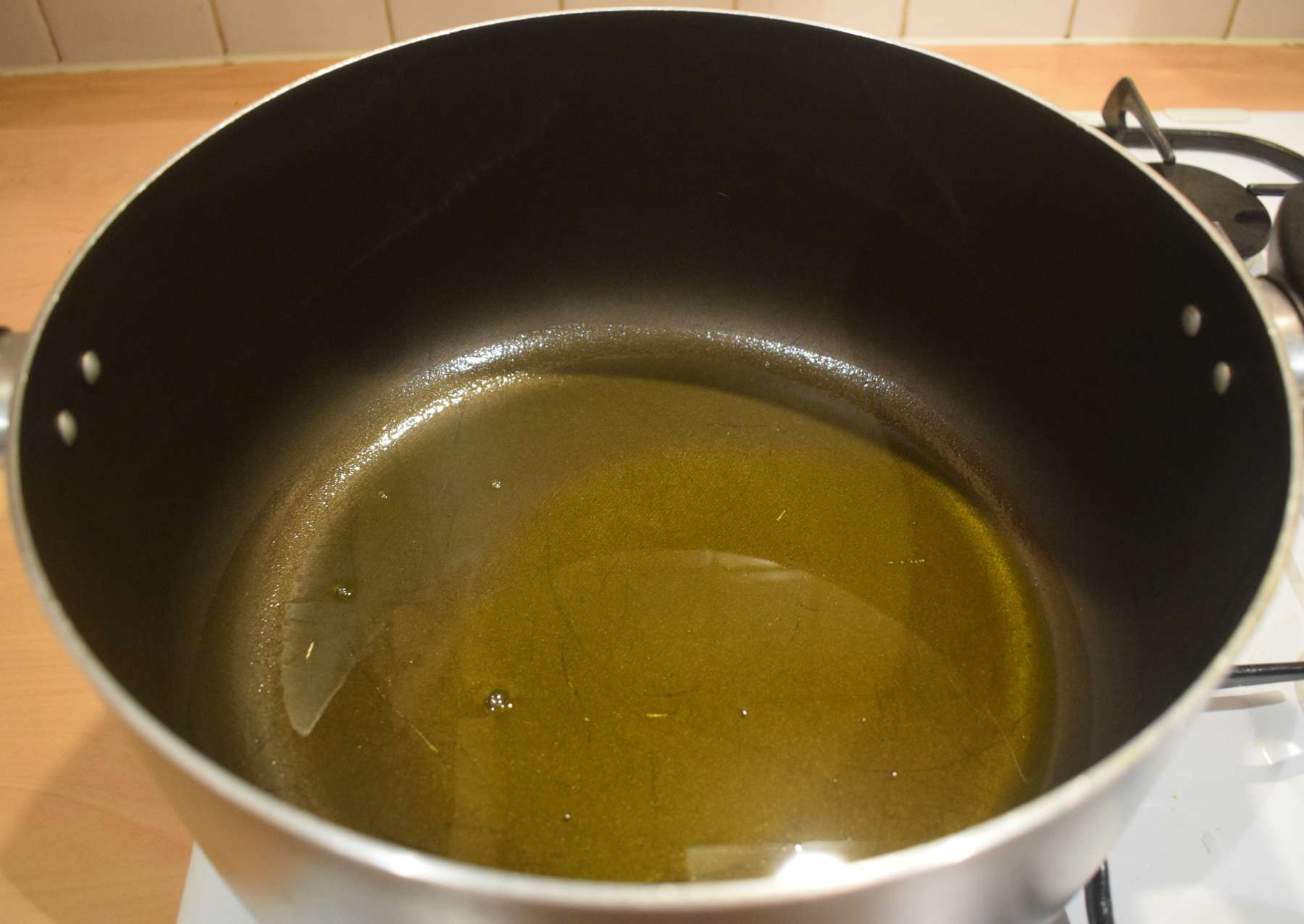
- Add the cauliflower florets into the pan and fry them on high flame for 2 minutes until brown spots occur on the body of the florets. Strain the excess oil and transfer the florets on a separate plate.
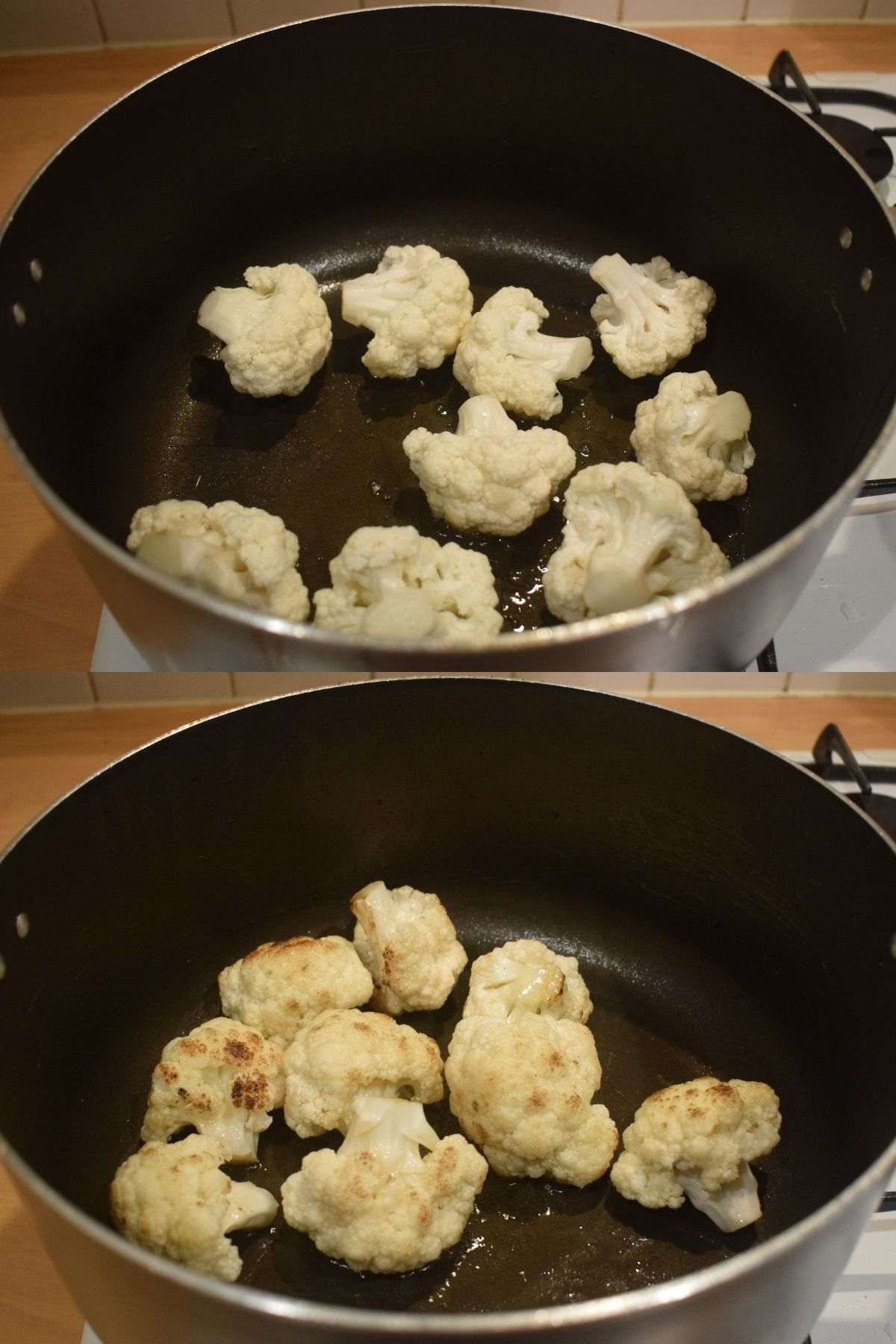
- Add the brinjal pieces into the pan and fry them over high flame for 2-3 minutes. Most probably the brinjal will soak most of the oil of the pan. Keep it aside.
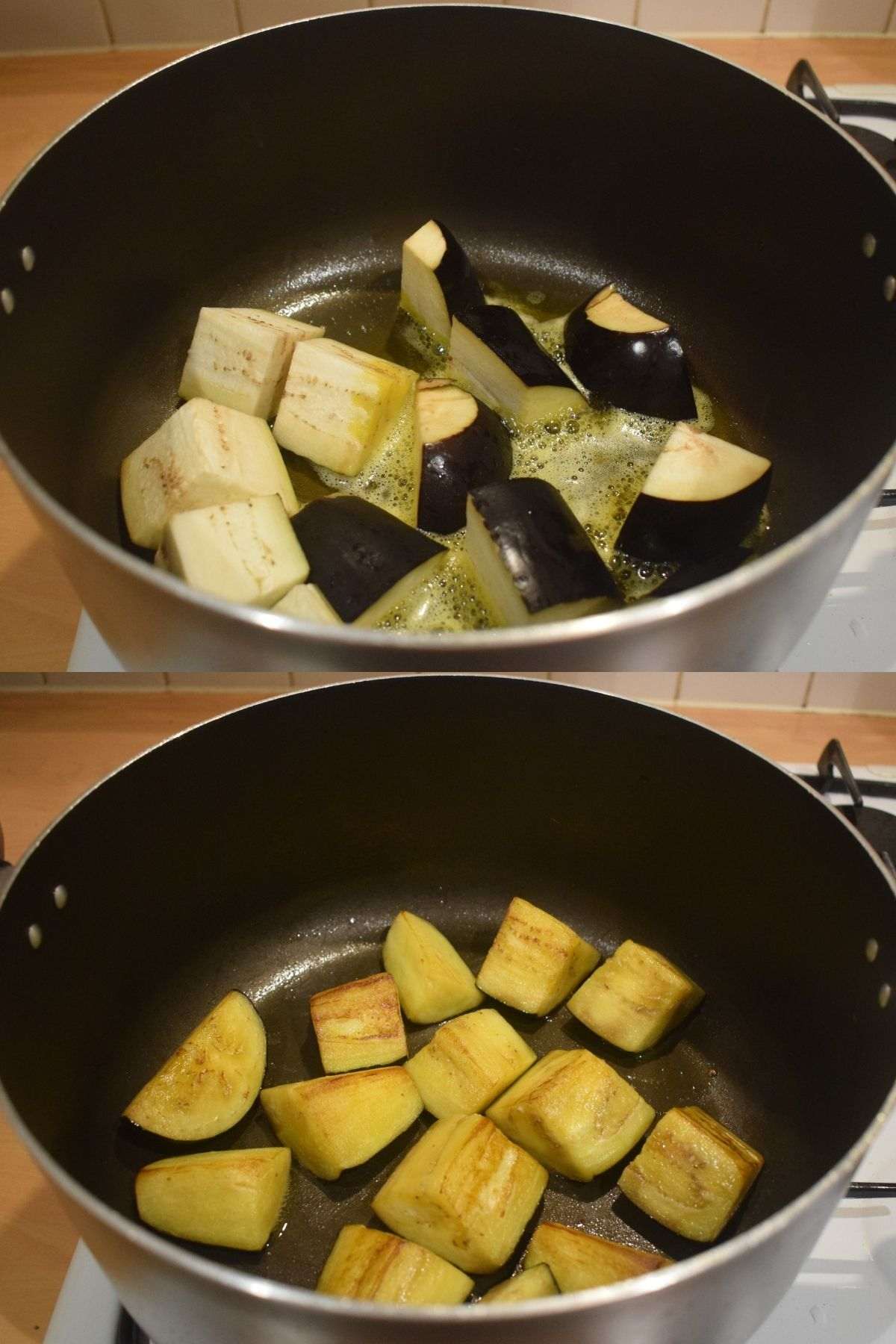
- Add the broad beans into the pan and fry them over high flame for 1 minute and transfer them to a plate.

- Add ¼ cup + 1 tablespoon mustard oil into the same pan and allow the oil to become hot. Add ½ tablespoon panch phoran, 3 bay leaves, 2-3 dry red chillies into the pan and let them crackle.
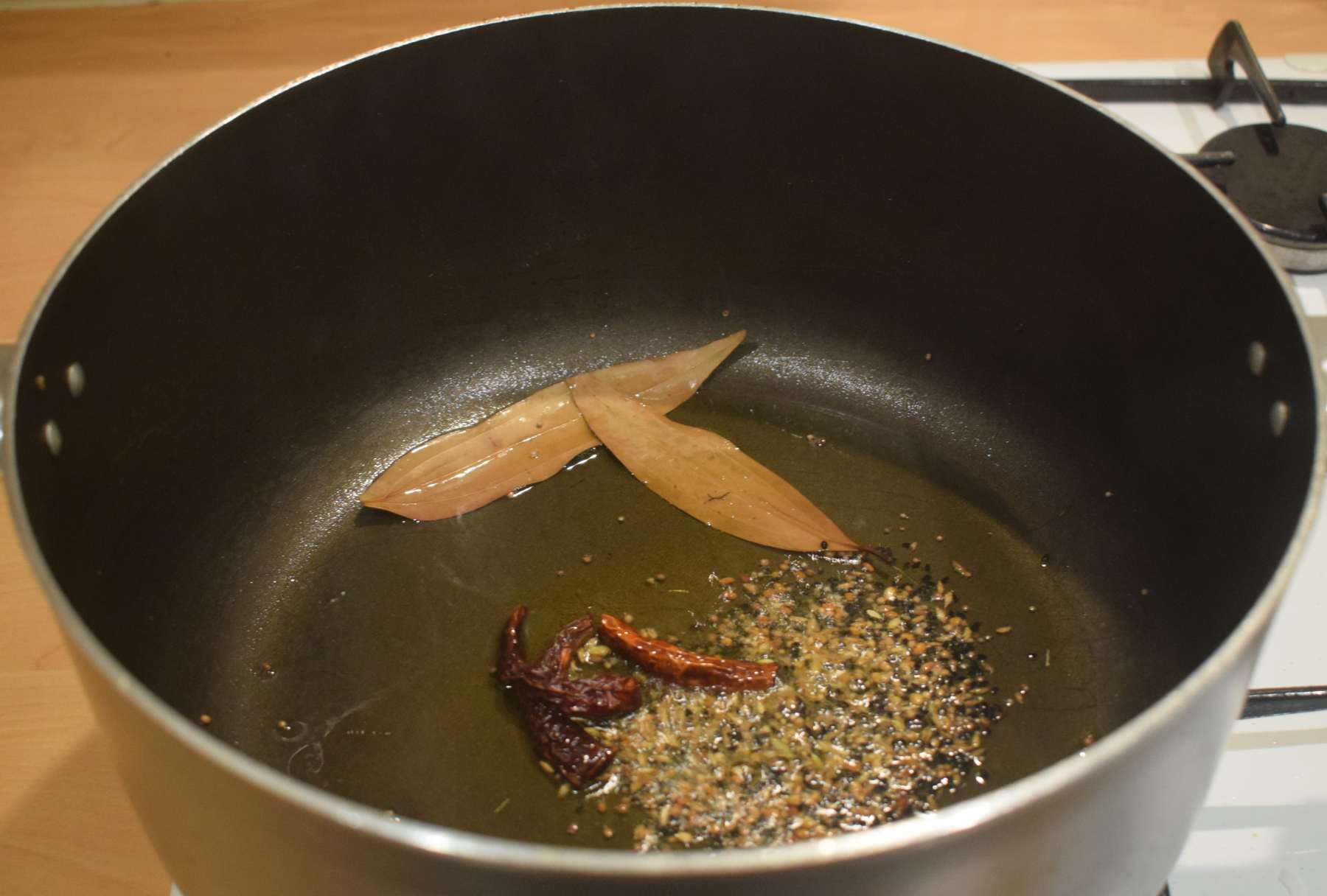
- Add the potatoes and taro pieces into the pan and fry them over high flame for 2-3 minutes. Stir frequently.
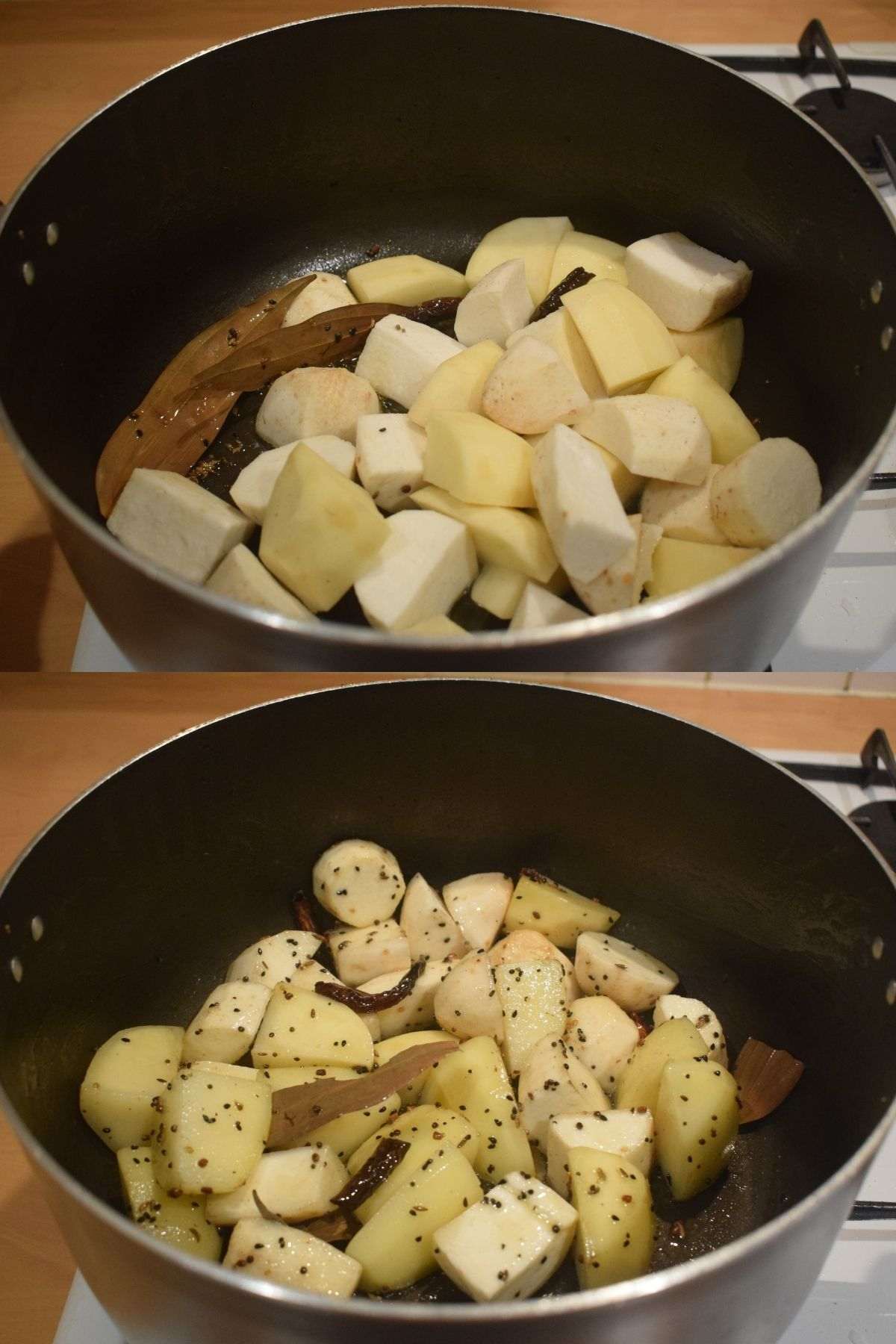
- Add the carrots, sweet potatoes into the pan and fry them evenly for another 2-3 minutes over high flame.

- Add the pumpkin, radish, cabbage pieces into the pan and give a nice mix. Cook it over high flame and stir nicely for 2 minutes so that all the vegetables get fried nicely. Then put the flame in medium and cover the pan for 5-6 minutes.

- Add fried cauliflower florets (Step 4), raw banana, borboti (yard long beans) and ridge gourd into the pan and give a nice mix. Cover the pan and cook it in medium flame for another 10 minutes. Stir twice in between.
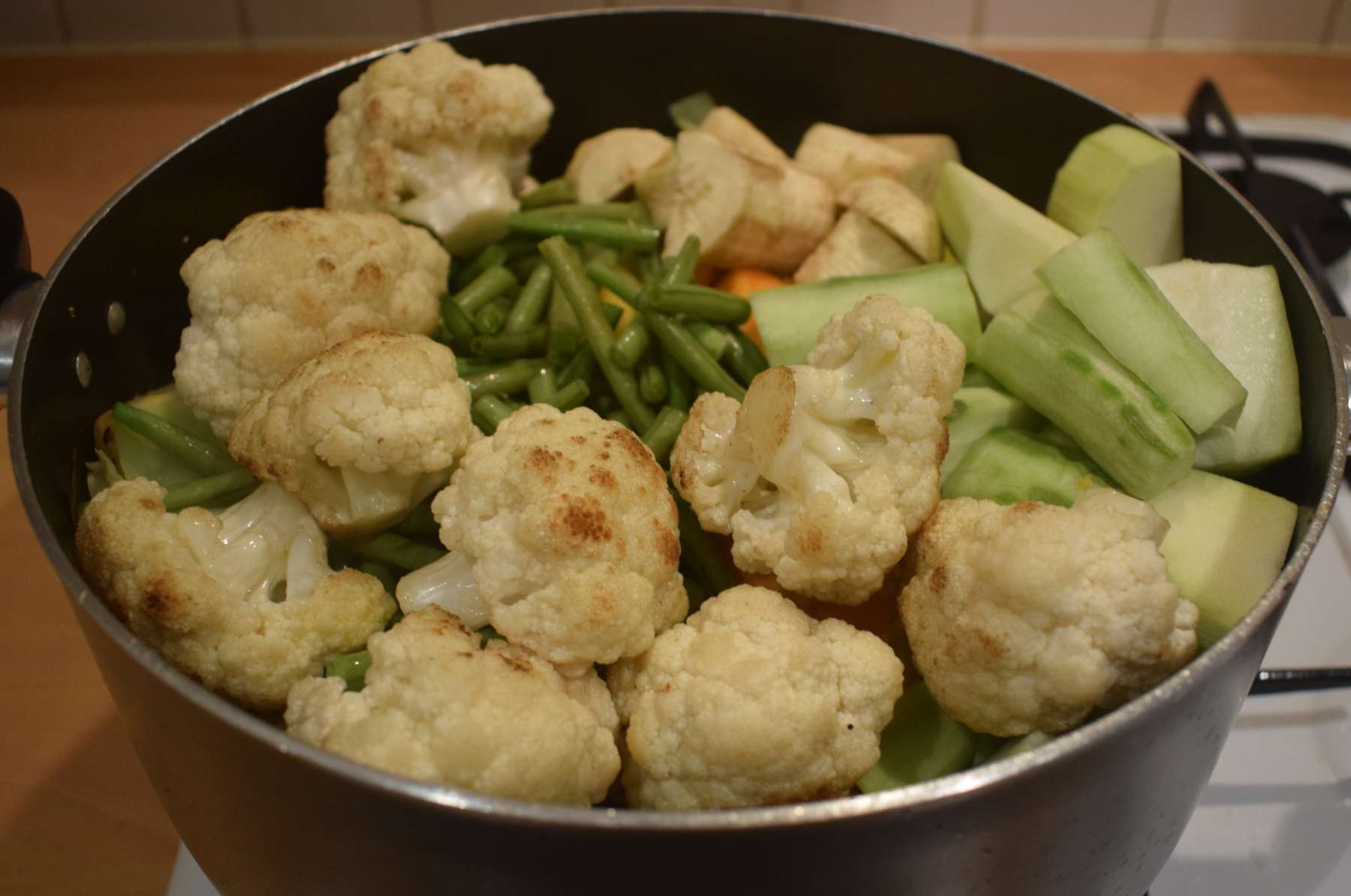
- Add the chopped spinach and salt, one by one into the pan and give a nice mix. Cover the pan and cook it over medium flame for another 5 minutes.
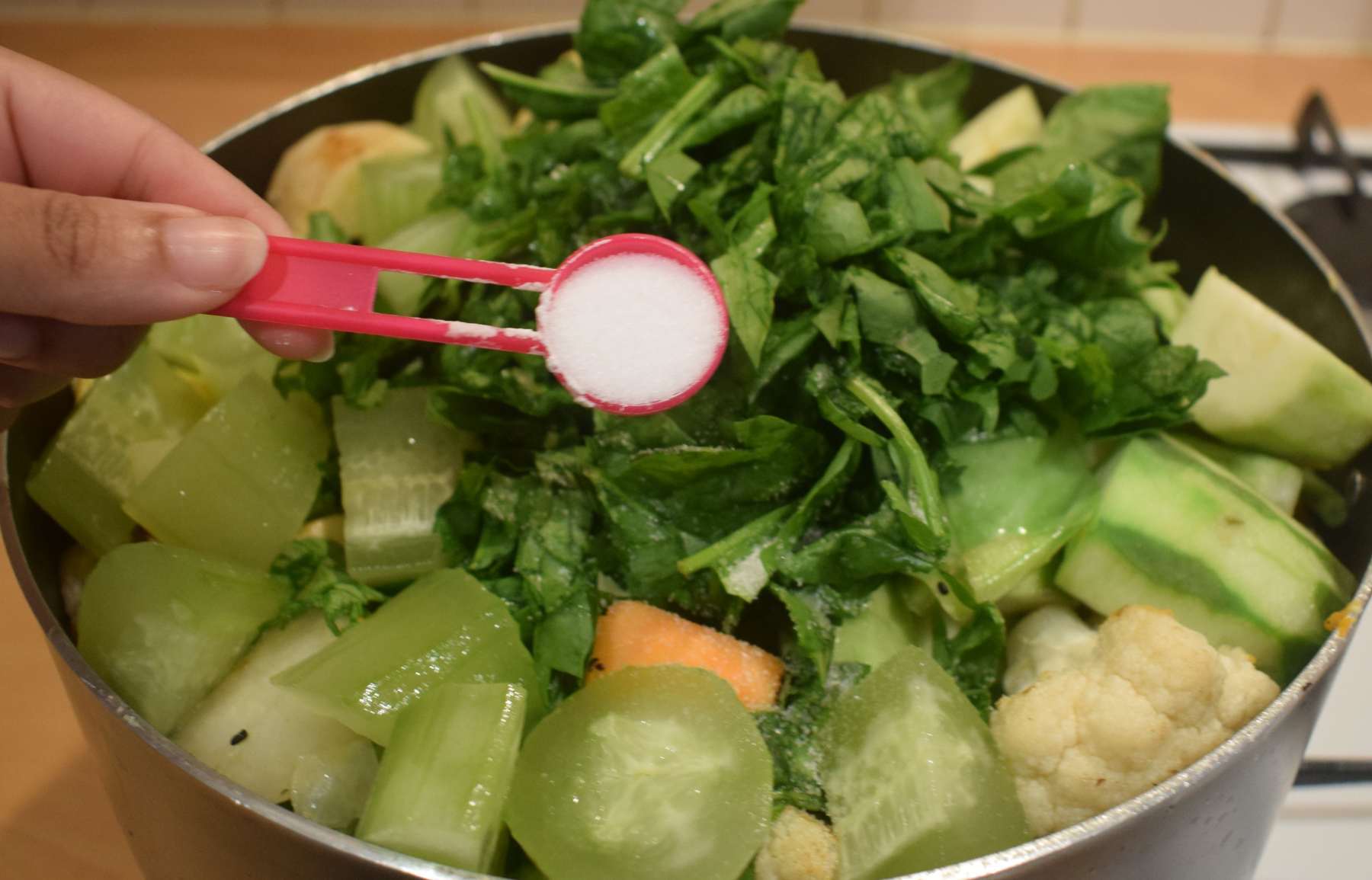
- Add ¾ cup grated coconut into the pan and give a nice mix. Cover the pan and cook it over medium flame for another couple of minutes.
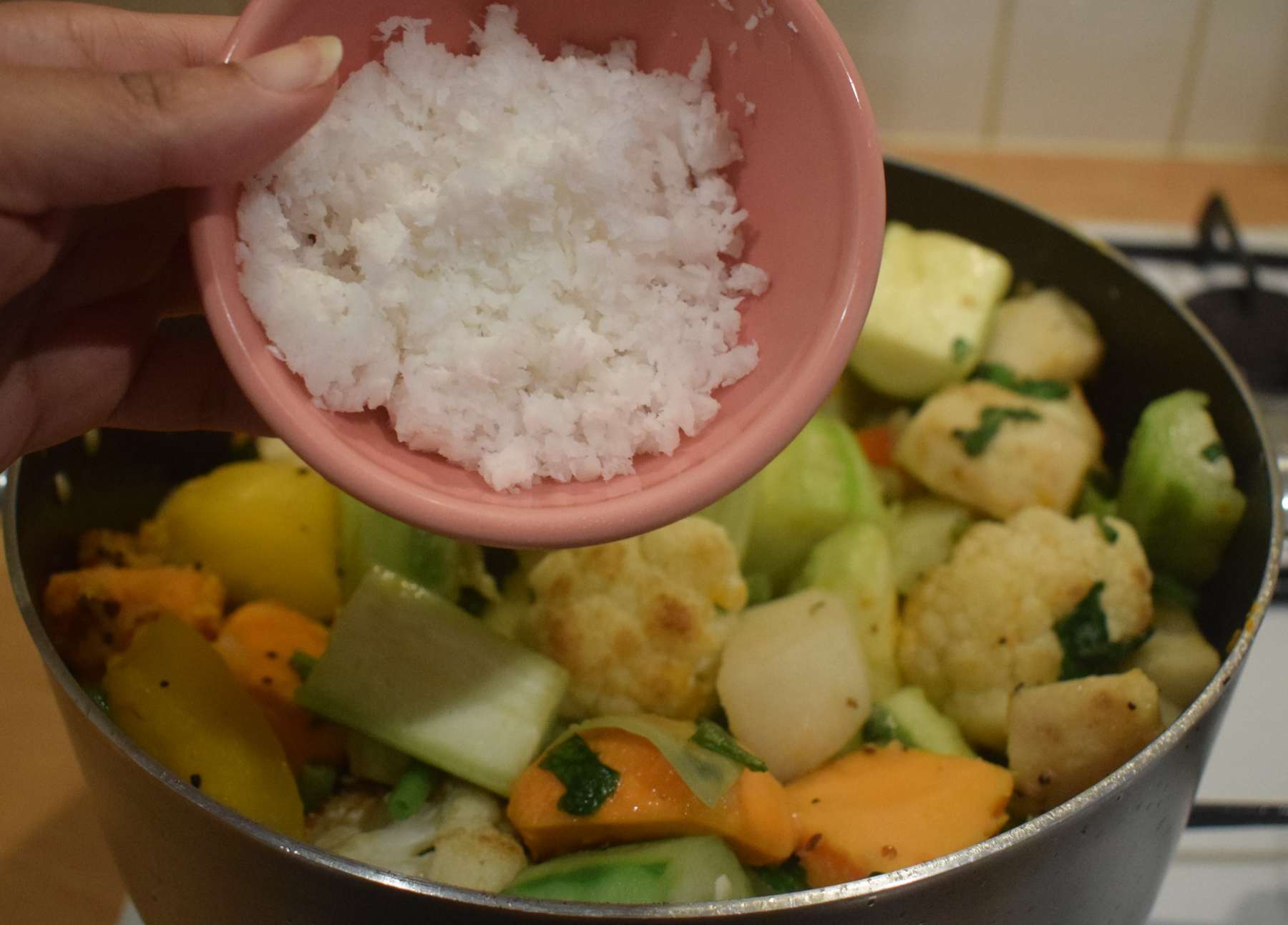
- Add the masala paste (Step 2) into the pan and mix it well.
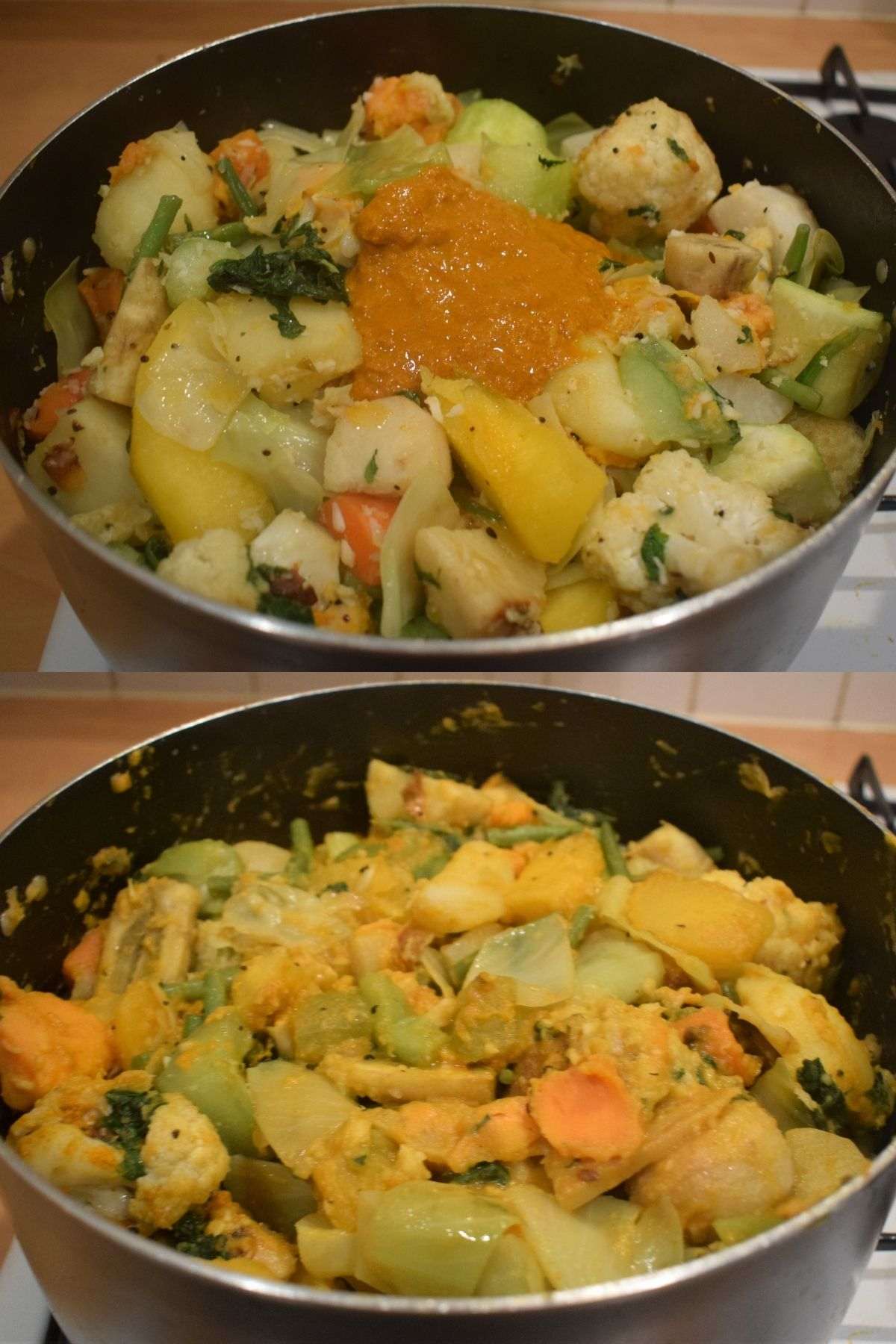
- Add the fried broad beans (Step 6) into the pan and mix it well. Again, cover the pan and cook it over low flame for 10-15 minutes until the all the vegetables get cooked. Stir in between.
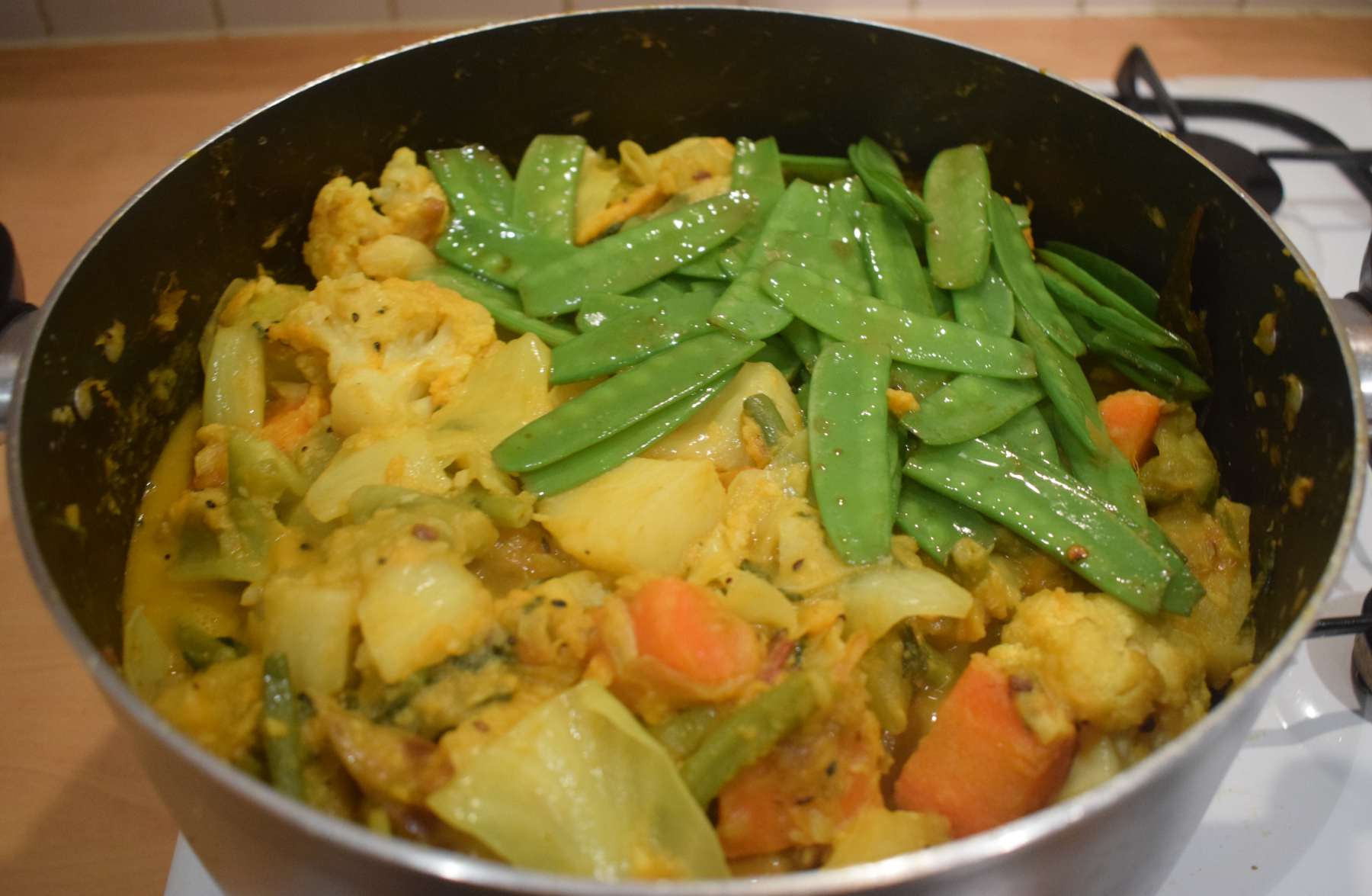
- Add the fried brinjal pieces (Step 5), 3-4 green chillies, 2 teaspoons sugar into the pan and mix it well. Cover the pan and cook it in low flame for another 5-6 minutes. Check all the vegetables whether they are cooked or not. If not, then cover the pan and cook it in low flame for another 5 minutes.
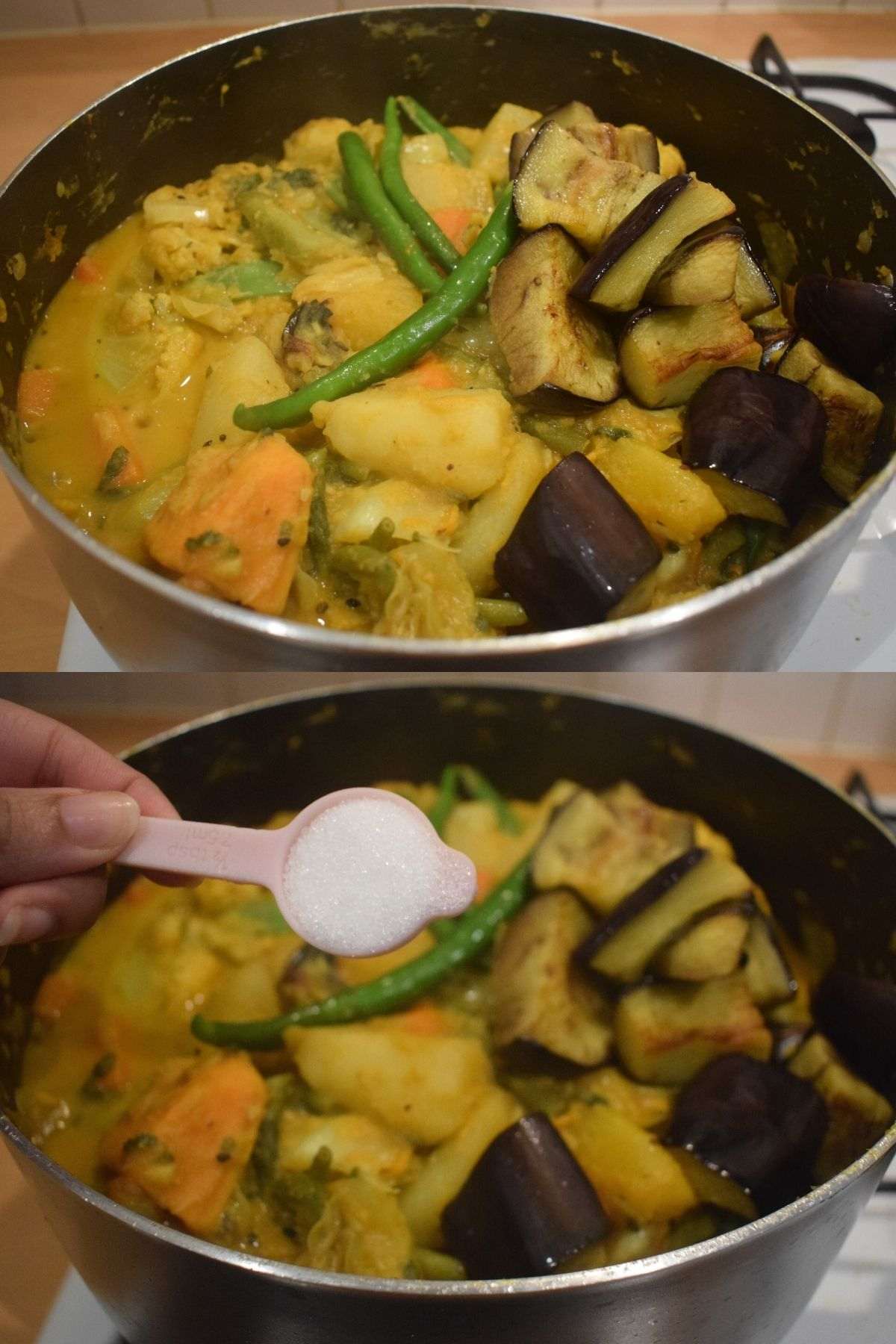
- Add 1 tablespoon bhaja masala, 1 tablespoon ghee into the pan and give a nice mix. Check the salt and add more if required. Put the flame in high and cook it for a minute. Stir in regular interval.
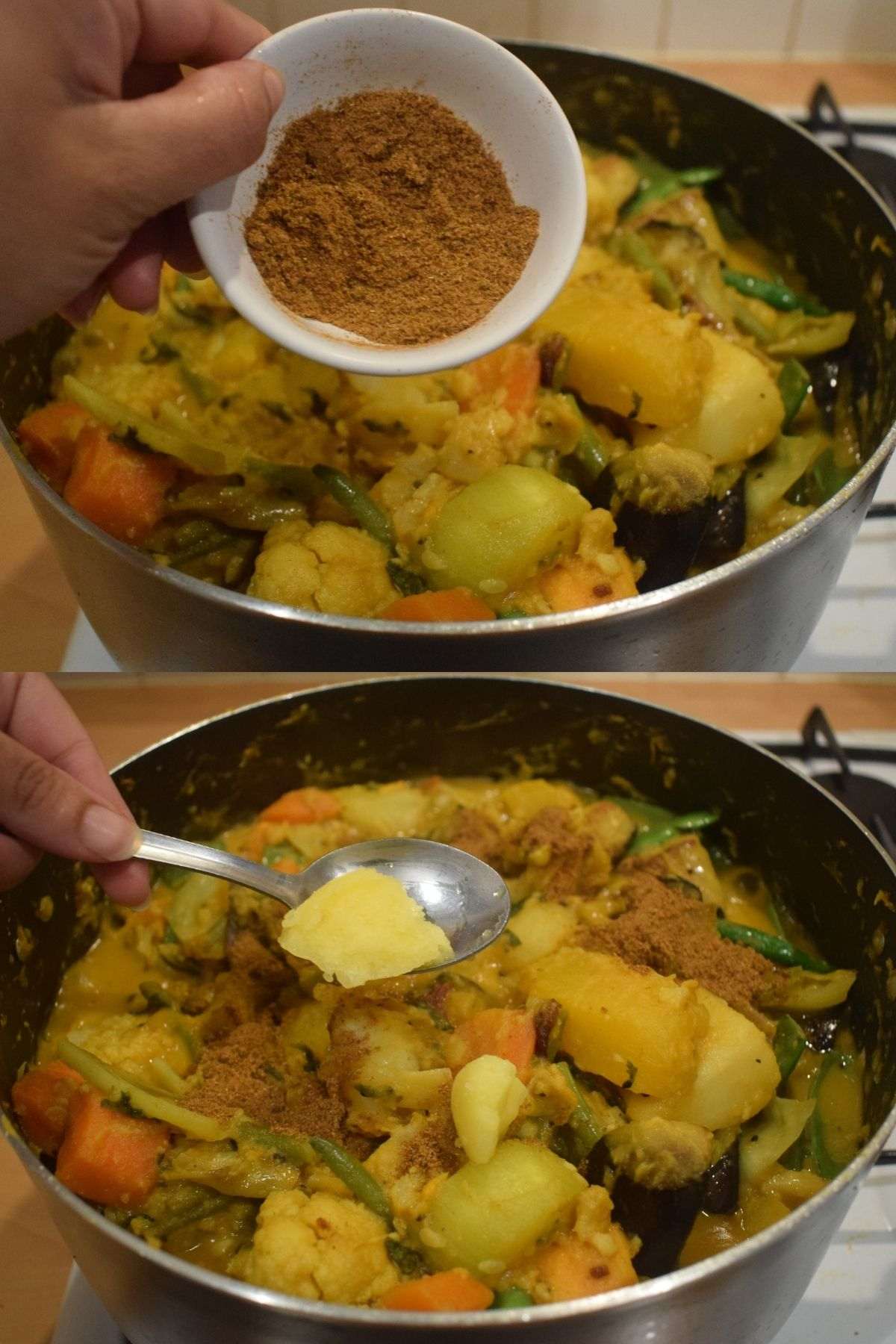
- Switch off the flame and cover the pan. Don’t disturb the pan for another 10-15 minutes. Allow it to rest to absorb all the flavours.
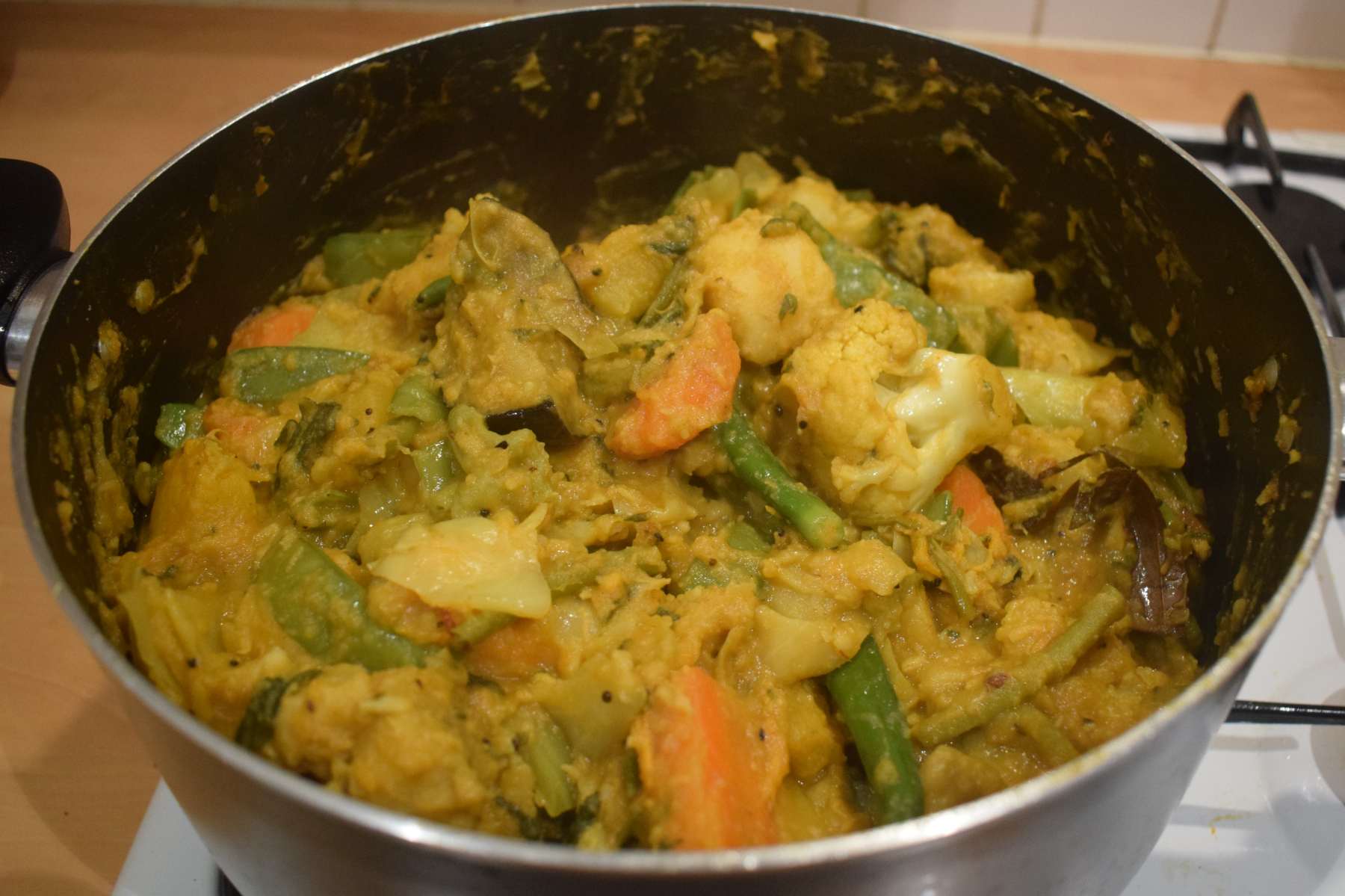
- Now your labra recipe is ready to serve.
Serving Instruction
Serve the portions of Bhoger labra recipe on serving plates. Pair up the authentic dish with bhoger khichuri or bhuni khichuri. Serve hot or warm and enjoy the eternal taste from the core of your heart.
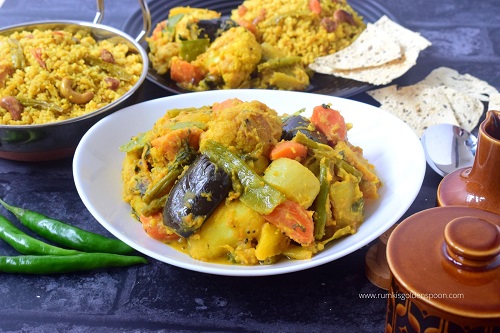
Ingredients
1 cup = 250 ml
- 2 medium Potatoes
- 1 large sweet Potato (Mishti aloo)
- 3 Taro roots (Gathi kochu)
- 300 grams Pumpkin (Kumro)
- 1 large Radish (Mulo)
- 2 Medium Carrots
- 1 unripe Banana (Kachakola)
- 1 large Ridge Gourd (Jhinge)
- 10 large florets of Cauliflower
- 1 small Cabbage
- 1½ cup Spinach, chopped
- 100 grams broad Beans (Sheem)
- 100 grams Yard long Beans (Borboti)
- 3-4 green Chillies
- ¾ cup Coconut, grated or paste
For tempering
- ½ tablespoon Panch Phoran
- 2-3 Bay leaves (Tejpatta)
- 3 dry red Chillies (Shukno lonka)
For masala paste
- 1½ tablespoons Ginger paste
- 3 teaspoons Turmeric powder
- 2-3 teaspoons red Chilli powder (Adjust accordingly)
- 1½ teaspoons Cumin powder
- 3 tablespoons Water
Other ingredients
- 1 tablespoon Bengali bhaja masala
- 2 teaspoons Sugar
- Salt to taste
- 1 tablespoon clarified Butter (Ghee)
- 155ml Mustard Oil for cooking (App. ½ cup +1 tablespoon)
Instructions
- Peel the vegetables and wash them. Then cut the potatoes, sweet potatoes, taro, carrots, radish, brinjal, pumpkin, ridge gourd into large pieces. Cut the cauliflower into large florets and chop the cabbage roughly into medium pieces. Peel the raw banana carefully and cut them into large pieces. Trim the edges of the broad beans and borboti and cut them into 3 inches pieces. Wash the spinach thoroughly and chop them. Keep all the vegetables aside.
- Now take a small bowl and add 1½ tablespoons ginger paste, 3 teaspoons turmeric powder, 2-3 teaspoons red chilli powder, 1½ teaspoons cumin powder and 3 tablespoons water into it. Make a paste of the spices and keep it aside.
Note: You can also add green chilli paste into the mixture if you prefer heaty taste.
- Now put a large pan on flame and allow it to become completely dry. Then add ¼ cup mustard oil into the pan and wait until the oil is hot.
- Add the cauliflower florets into the pan and fry them on high flame for 2 minutes until brown spots occur on the body of the florets. Strain the excess oil and transfer the florets on a separate plate.
- Add the brinjal pieces into the pan and fry them over high flame for 2-3 minutes. Most probably the brinjal will soak most of the oil of the pan. Keep it aside.
- Add the broad beans into the pan and fry them over high flame for 1 minute and transfer them to a plate.
- Add ¼ cup + 1 tablespoon mustard oil into the same pan and allow the oil to become hot. Add ½ tablespoon panch phoran, 3 bay leaves, 2-3 dry red chillies into the pan and let them crackle.
- Add the potatoes and taro pieces into the pan and fry them over high flame for 2-3 minutes. Stir frequently.
- Add the carrots, sweet potatoes into the pan and fry them evenly for another 2-3 minutes over high flame.
- Add the pumpkin, radish, cabbage pieces into the pan and give a nice mix. Cook it over high flame and stir nicely for 2 minutes so that all the vegetables get fried nicely. Then put the flame in medium and cover the pan for 5-6 minutes.
- Add fried cauliflower florets (Step 4), raw banana, borboti (yard long beans) and ridge gourd into the pan and give a nice mix. Cover the pan and cook it in medium flame for another 10 minutes. Stir twice in between.
- Add the chopped spinach and salt, one by one into the pan and give a nice mix. Cover the pan and cook it over medium flame for another 5 minutes.
- Add ¾ cup grated coconut into the pan and give a nice mix. Cover the pan and cook it over medium flame for another couple of minutes.
- Add the masala paste (Step 2) into the pan and mix it well.
- Add the fried broad beans (Step 6) into the pan and mix it well. Again, cover the pan and cook it over low flame for 10-15 minutes until the all the vegetables get cooked. Stir in between.
- Add the fried brinjal pieces (Step 5), 3-4 green chillies, 2 teaspoons sugar into the pan and mix it well. Cover the pan and cook it in low flame for another 5-6 minutes. Check all the vegetables whether they are cooked or not. If not, then cover the pan and cook it in low flame for another 5 minutes.
- Add 1 tablespoon bhaja masala, 1 tablespoon ghee into the pan and give a nice mix. Check the salt and add more if required. Put the flame in high and cook it for a minute. Stir in regular interval.
- Switch off the flame and cover the pan. Don’t disturb the pan for another 10-15 minutes. Allow it to rest to absorb all the flavours.
- Now your labra recipe is ready to serve.

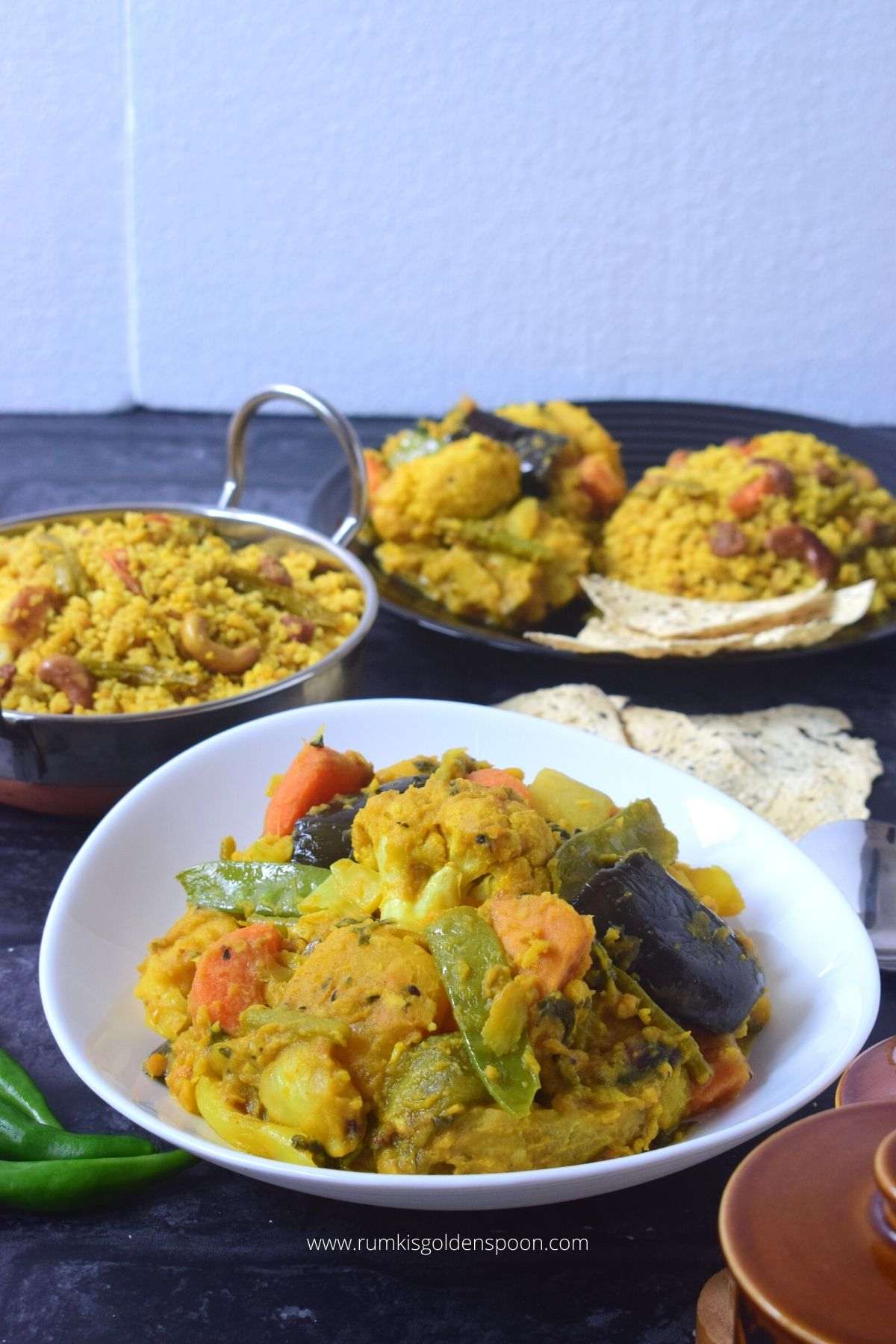
1 comment
[…] khichuri Bhoger labra Luchi recipe Kumror […]